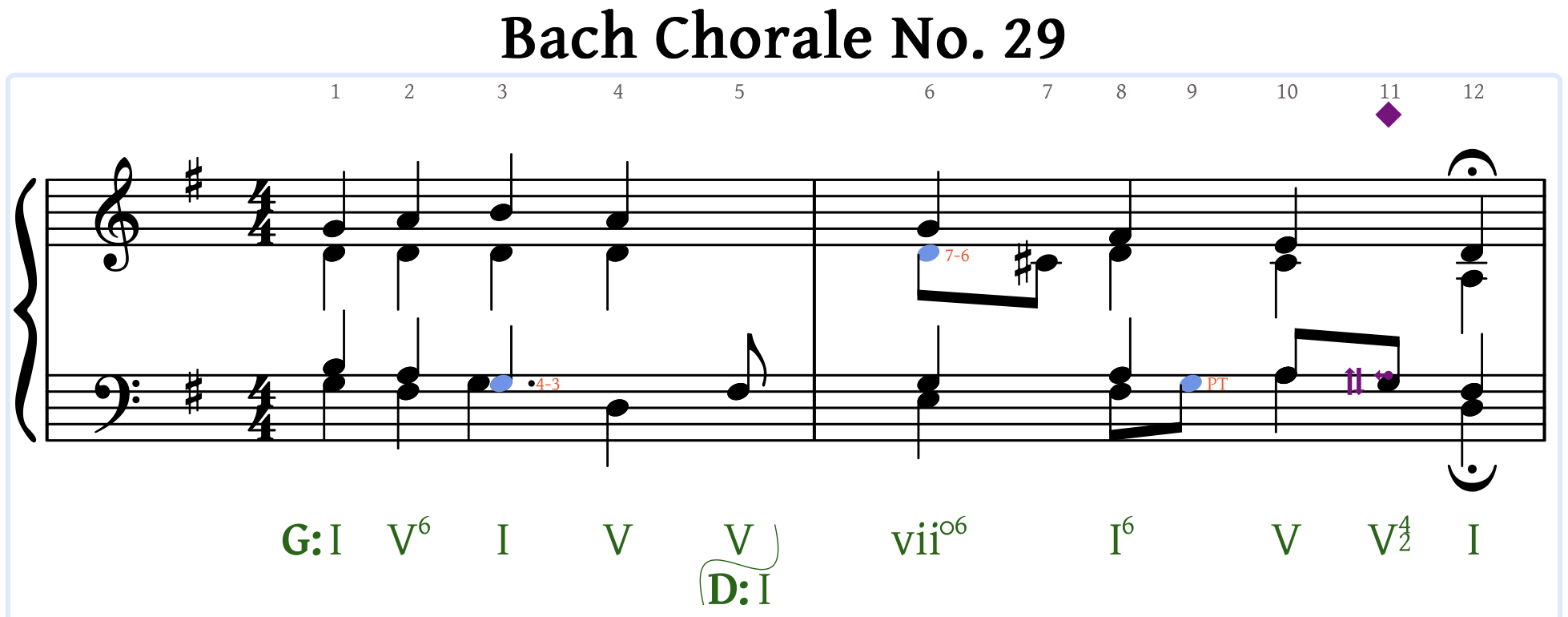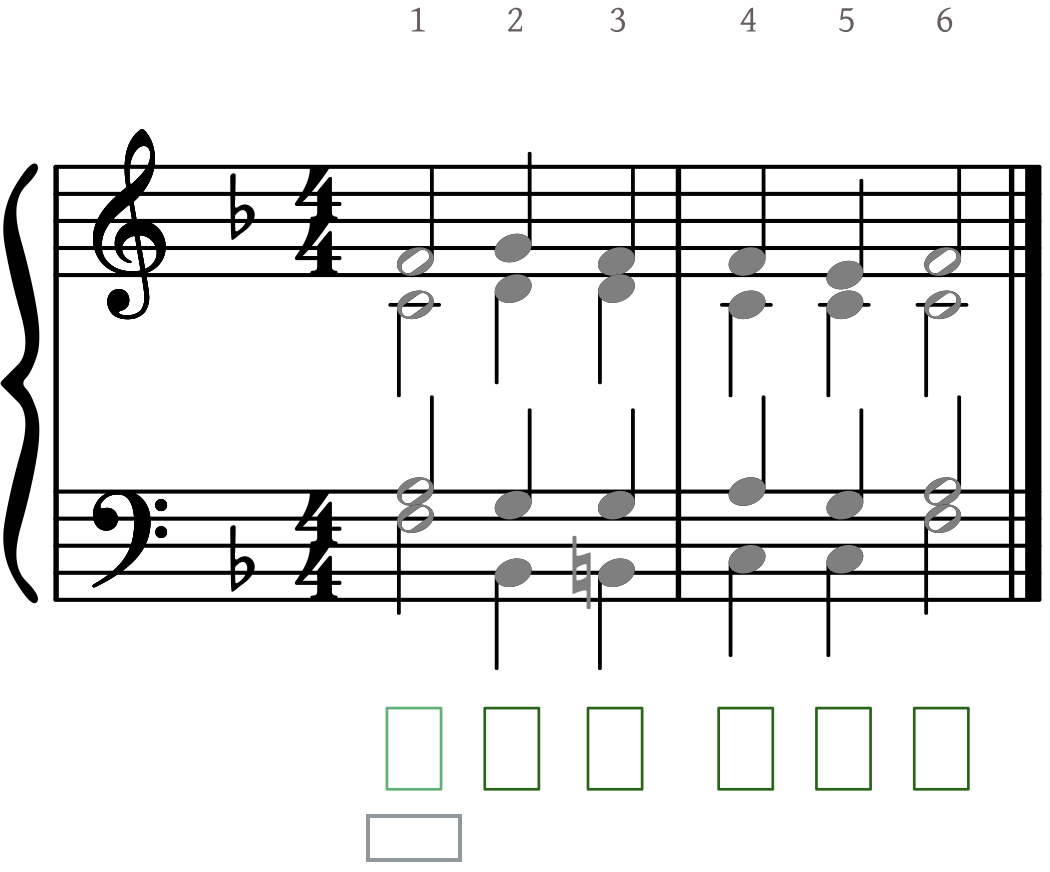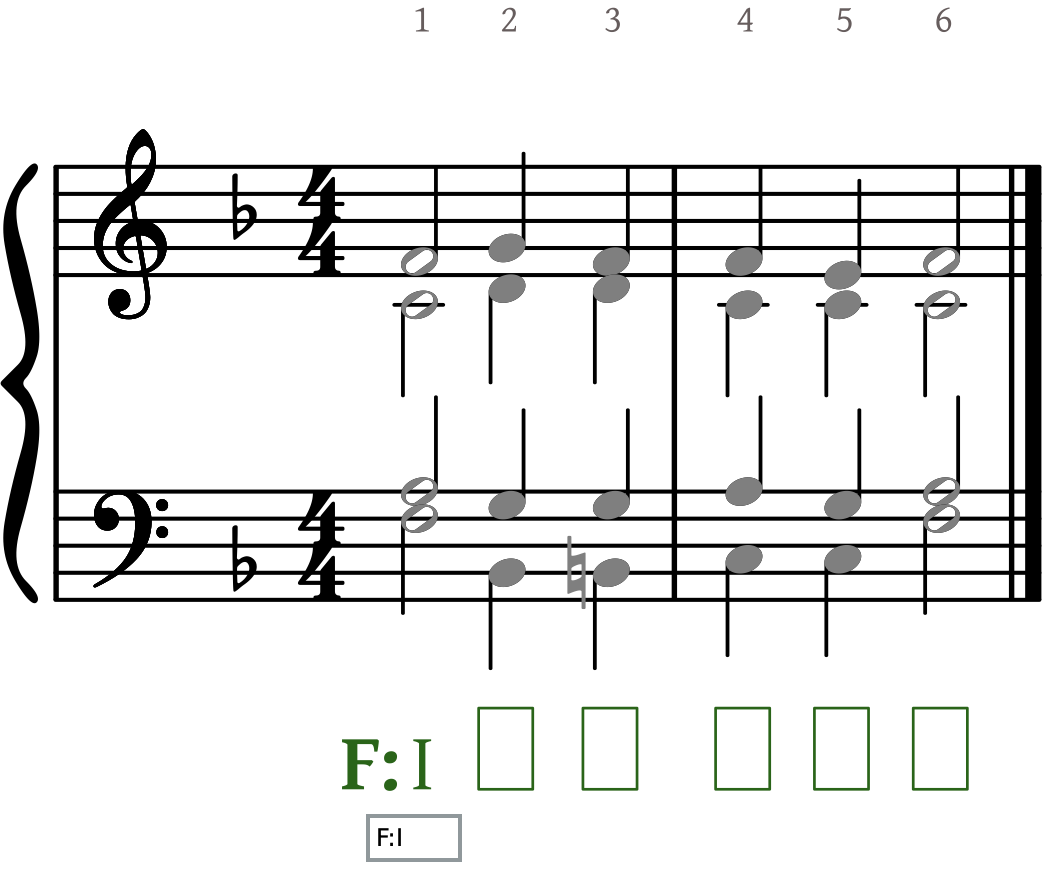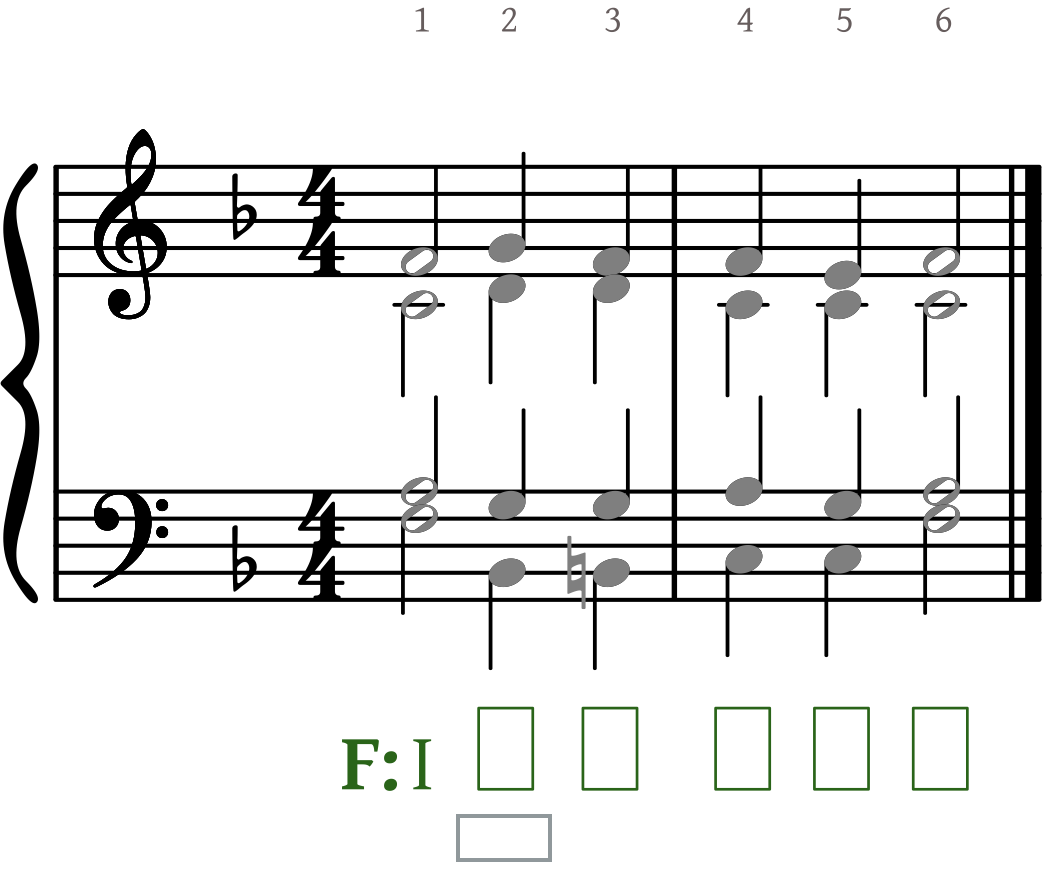SUPPORT
Typing Roman Numerals

Roman numeral notation provides a concise and simple way to express both the scale degree and the quality of different chords. In a roman numeral, scale degrees are expressed as roman numbers (I to VII) for the seven diatonic degrees (tonic to leading-tone) with the additional feature that the roman number is capitalized if the chord is major or augmented and lowercase for minor or diminished chords. Diminished and augmented roman numerals additionally include the characters ° and +, respectively.
To enter a roman numeral, click on the theory-line entry and type the chord's degree, quality, and its inversion (if applicable) in the text-input box.
This table shows the roman numerals for the most common triads and sevenths in major and minor keys:
degree: text input: degree: text input: tonic I, i tonic I7, i7 supertonic ii, iio supertonic ii7, ii/o7 mediant iii, III mediant iii7, III7 subdominant IV, iv subdominant IV7, iv7 dominant V, v dominant V7 submediant vi, VI submediant vi7, VI7 leading-tone viio, VII leading-tone viio7, vii/o7
- To distinguish minor from diminished chords, diminished roman numerals include the diminished-quality character 'o' (typed as a lowercase ‘o’). For more information about chord qualities, see Table of Chord Qualities.
- All seventh chords (and triads other than those in root positions) include a seventh or inversion information, if applicable, immediately following the roman numeral. For information about chord inversions, see Table of Chord Inversions.
Major and Minor Keys
A roman numeral theory-line entry can include a key as a constituent part of its symbol. For example, the first roman numeral of a roman-numeral analysis almost always provides the home key of the piece to indicate the underlying tonality. (See sonority 1 in the Bach Chorale example above). If the key changes later on in the composition, a direct modulation or a common-chord or pivot modulation will include a new key in a roman numeral theory-line entry to mark the point where the new tonality begins (see sonority 5 in the example above).
To enter a key, click on the theory line entry and type the tonic and mode of the tonality followed by a colon ':' in the text input box. For major keys the tonic pitch is uppercase, for minor keys the tonic pitch is lowercase. The colon serves to unambiguously identify the text as belonging to a key and separates it from the remaining text in the roman numeral.
major keys: text input: minor keys: text input: C C: C c: C♯ C#: C♯ c#: D♭ Db: D d: D D: D♯ d#: E♭ Eb: E♭ eb: E E: E e: F F: F f: F♯ F#: F♯ f#: G♭ Gb: G g: G G: G♯ g#: A♭ Ab: A♭ ab: A A: A a: B♭ Bb: A♯ a#: B B: B♭ bb: C♭ Cb: B b:
Modal Keys
You may at some point need to provide a modal key, such as D dorian or A mixolydian.
To enter a modal key you type an upper case tonic pitch , followed by enough of the mode name to make it unique and ending with a colon ':'. This table shows typical entries using the first three characters of the mode name.
This table shows typical entries using the first three characters of the mode name.
*Note that there is no Ionian or Aeolian, use Major and Minor instead.
modal keys: text input: D dorian Ddor: D phrygian Dphr: D lydian Dlyd: D mixolydian Dmix: D ionian Dmaj: D aeolian Dmin:
Tonicizations
To enter a tonicization (applied/secondary dominant and its resolution), provide two roman numerals separated by a slash '/'. The first roman numeral is the applied/secondary chord (dominant or leading-tone chord) and the second is the target chord. This table shows some typical tonicization entries:
tonicization: input text: V of vi V/vi vii°7 of V viio7/V V65 of IV V65/IV
- The first (applied/secondary) chord should include whatever inversion information is necessary to describe the chord.
- The second (target) chord is the "theoretical goal" of the applied/secondary chord and should not include inversion information.
Direct and Pivot (or Common-Chord) Modulations
There are two kinds of modulations: direct modulations and pivot modulations. A direct modulation simply asserts that a new tonality has been established at a particular chord. A pivot modulation identifies a single chord as being shared between the old tonality and the (new) tonality being established in the modulation. Since by definition a pivot chord belongs to both tonalities, it will require two roman numerals to describe it.
To enter a direct modulation, click on the theory-line entry and type the text input that consists of a key: and a roman number (which is almost always I, i.e. the tonic chord of the key being established). From the software's perspective then, the key associated with the first entry in a roman numeral analysis is just a direct modulation that establishes the home key of the composition. For information about how to type keys in roman numerals see the section Major and Minor Keys.
To enter a common-chord or pivot modulation, provide two romans separated by an equal sign '=', e.g. 'vi=G:ii'. The left side of the '=' contains the pivot chord's roman numeral in the old key and the right side provides the new key label and the chord's (new) roman numeral in the new key. This table shows some typical pivot entries where the old tonality is assumed to be G major:
pivot: text input: vi becomes ii in D major vi=D:ii iii becomes i in B minor iii=b:i IV becomes bVI in E minor IV=e:bVI
Cadential Six-Four Chords
A cadential six-four chord is a voice-leading chord that often decorates a dominant chord at important cadence points. To specify a cadential six-four chord in the theory line, type cad64 and you will see the appropriate symbol engraved in the theory link depending on whether or not your teacher labels these chords using the V64=53 convention or the I64 - V convention. Note: if you label your cadential six-four chord as V64=53 you will have to type V or V7 rather than just 53 or 753 for the second chord.
Borrowed Chords
A borrowed chord is a chord that is taken from the parallel major or minor of the current key. If the root of the borrowed chord is the same as the diatonic chord's root, then the only thing that changes is the quality of the roman chord. If the root is also modified, then the root's chromatic alteration will be indicated by a flat (if lowered by half step) or sharp (if raised by half step) preceding the roman numeral label. Here is a table of typical chords borrowed in major and minor keys:
major key: text input: minor key: text input: minor tonic i major tonic I diminished supertonic iio minor supertonic ii lowered mediant bIII — — minor subdominant iv minor subdominant IV lowered submediant bVI raised submediant #vi
- Flats preceding a roman numeral lower the chord root by half step.
- Sharps preceding a roman numeral raise the chord root by half step.
- Since the leading-tone chord in minor keys is, by definition, already raised, do not add a sharp when a subtonic chord is raised by half step.
Neapolitan chords
A Neapolitan chord is a major triad built on the lowered-supertonic scale degree of a major or minor key. It is typically, but not always, found in first inversion.
To enter a Neapolitan chord, click on the theory line entry and type either an altered roman numeral bII or the special symbol N, followed by the chord's inversion (if applicable) in the text-input box.
* Note that if no inversion is specified, the default inversion of a Neapolitan is root position, not first inversion. Depending on how your instructor configured your course, the Neapolitan chord will be displayed in the theory line as N or bII.
neapolitan: text input: root position N, bII first inversion N6, bII6 second inversion N64, bII64
Augmented Sixth Chords
An augmented sixth chord is a sonority that is probably less a chord than it is a voice leading structure. It is traditionally defined as a chromatically altered predominant chord that features the tonic pitch plus an interval of an augmented sixth (created by a minor sixth scale degree in the bass (le) and a raised fourth (fi) in an upper voice) that moves out by half steps in contrary motion to a dominant octave, harmonized by V or Cad64-V.
To enter an augmented sixth chord, click on the theory-line entry and type the name of the chord and (optionally) its inversion in the text input box. Harmonia distinguishes between four types of augmented sixth chords: Italian, German, French and Swiss.
Italian augmented sixth chords contain 2 tonics (do), a lowered submediant (le), and a raised subdominant (fi).
French augmented sixth chords contain 1 tonic (do), supertonic (re), a lowered submediant (le), and a raised subdominant (fi).
German augmented sixth chords contain 1 tonic (do), a lowered mediant (me), a lowered submediant (le), and a raised subdominant (fi).
The Swiss augmented sixth chord sounds the same as the German augmented sixth chord, but is based on a different chordal root when stacked in thirds and so is spelled differently (see below). It contains 1 tonic (do), a raised second (ri), a minor sixth (le), and a raised fourth (fi).
The augmented sixth has no explicit inversion number, its inversion will default to positions that cause the lowered-submediant scale degree to be its bass tone.
*Notes:
augmented sixth: input text: Italian 6 It German 65 Gr, Ger French 43 Fr Swiss 43 Sw
- If no inversion number is specified for an Italian sixth, it will be in first inversion, e.g. It6.
- If no inversion number is specified for a German sixth, it will be in first inversion, e.g. Ger65.
- If no inversion number is specified for a French sixth, it will be in second inversion, e.g. Fr43.
- If no inversion number is specified for a Swiss sixth, it will be in second inversion, e.g. Sw43.
In tonal music, chord spelling is everything. The German sixth chord sounds the same as a dominant seventh chord but, depending on its key, has a different root, chord spelling and resolution path. A Swiss augmented sixth sounds the same as a dominant seventh chord (and a German sixth chord) and also has its own unique root, spelling and resolution path. Because the minor submediant typically appears in the bass of all augmented sixth chords, it may be useful to examine the "root positions" of the various augmented sixth chords when stacked in thirds to determine their typical inversions. For example, in the key C minor:
root position spelling of Italian 6: F♯ A♭ C root position spelling of German 65: F♯ A♭ C E♭ root position spelling of French 43: D, F♯ A♭ C root position spelling of Swiss 43: D♯, F♯ A♭ C
Typing in the Theory Line
To type roman numerals in a roman numeral analysis assignment, please follow the steps:
- Click on an entry box for the theory-line editor to pop up just beneath the theory line.
- Type the root, quality, and inversion (if applicable) of the chord as described above into the theory-line editor. As you type, your input will be engraved in the theory line into proper music notation.
- When you are finished typing, press the Enter or Return key or use the Tab key to move to the next entry in the theory line.



